What Is Greenwashing?
How this misleading marketing practice impacts consumers and communities and stands in the way of real environmental progress.
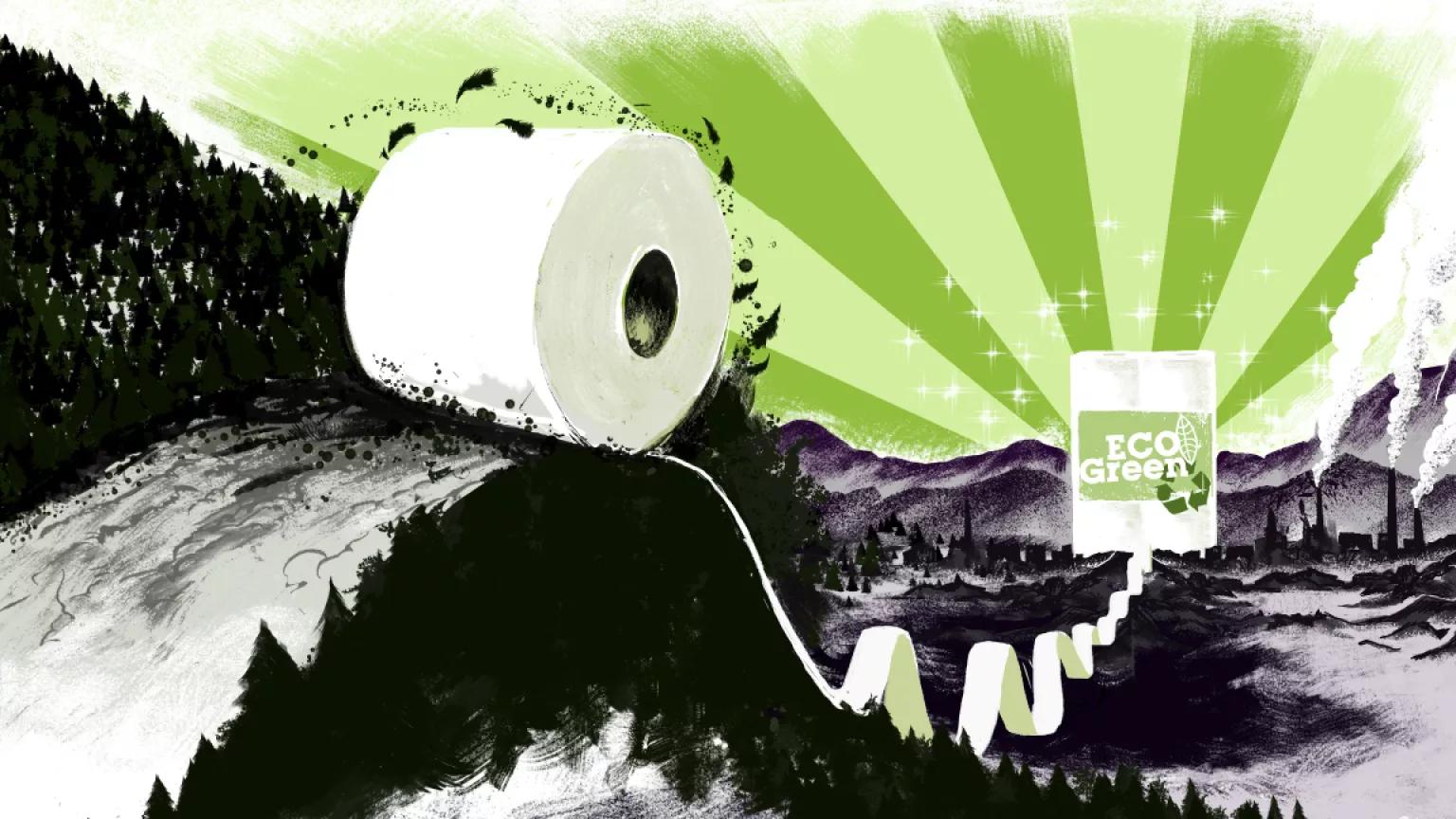
Aaron McConomy/Colagene, Creative Clinic for NRDC
In 2009, Volkswagen launched a wide-reaching marketing campaign to promote its “clean diesel” cars. Across print and televised ads, including in one prime-time Super Bowl commercial, the automaker touted a drastic reduction in the tailpipe emissions of its new VW and Audi models. “Green has never felt so right,” the Audi commercial bragged.
But a few years later, the U.S. Environmental Protection Agency (EPA) discovered that Volkswagen had installed software allowing it to cheat emissions tests for 11 million of its vehicles. The automaker’s so-called clean diesel cars actually produced nitrogen oxide emissions up to 40 times the legal limit. The resulting “Dieselgate” scandal marked one of the most notorious examples to date of deceptive environmental marketing—a phenomenon known as greenwashing—and ultimately cost Volkswagen nearly $40 billion.
But greenwashing is often far less sensational—and far harder to spot. We regularly encounter misleading sustainability claims on packaging for our everyday household items but also in, say, so-called sustainability initiatives promoted by major corporations. Given how urgent the climate, biodiversity, and public health crises have become, sorting sustainability fact from fiction is more important now than ever. Let’s get into what greenwashing can look like and what can be done about it.
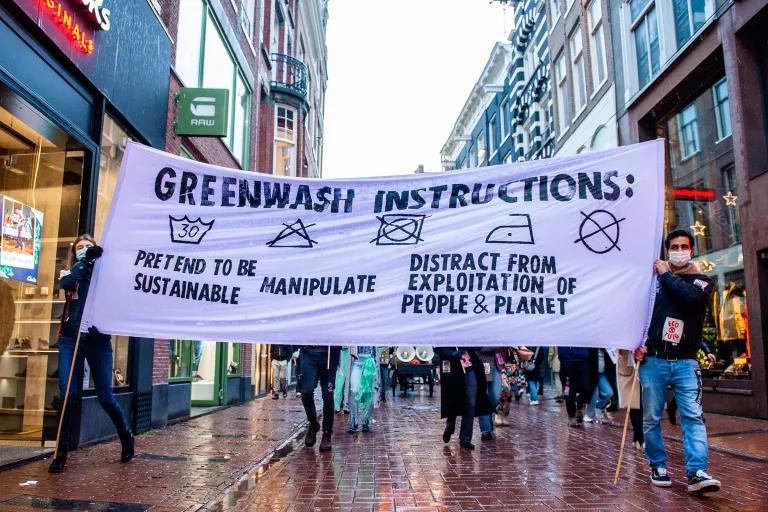
Ana Fernandez/SOPA Images/LightRocket via Getty Images
What does greenwashing mean?
Greenwashing is the act of making false or misleading statements about the environmental benefits of a product or practice. It can be a way for companies to continue or expand their polluting as well as related harmful behaviors, all while gaming the system or profiting off well-intentioned, sustainably minded consumers. The term was actually coined back in 1986 in an essay by environmentalist and then student Jay Westerveld. While visiting a hotel in Fiji, Westerveld noticed that it asked guests to reuse towels for the planet’s sake—a request that would also conveniently save the hotel money. Meanwhile, the hotel, located near sensitive island ecosystems, was in the middle of an expansion.
In the decades since, a number of high-profile greenwashing examples have made front-page news. In the 1980s, Chevron launched its infamous People Do campaign, touting its work protecting wildlife, even while the company continued to spill oil in sensitive ecosystems and drive climate change. And in the early 2000s, fossil fuel company BP coined the term “carbon footprint” when it launched a calculator for individuals to assess their personal emissions, avoiding the fact that its own emissions were among the highest on the planet.
But as environmentalism has gone mainstream—meaning more consumers are willing to pay for sustainable products, and the financial sector has turned its attention to environmental risk—greenwashing has gotten more sophisticated. “[Companies are] better at how they message it, so it doesn’t come across quite so badly. “says Todd Larsen, the executive co-director for consumer and corporate engagement at Green America, one of the first organizations to put together vetted lists of green businesses and products. “It’s more in the general marketplace now.”
What are some examples of how greenwashing shows up?
Greenwashing can still look like an overt, and potentially even illegal, lie. But as Larsen notes, most greenwashing is subtler and includes more insidious forms of manipulation, like these common strategies:
- Nature-based imagery—such as trees, leaves, or animals—on product packaging and in advertisements can imply sustainability, even if the company or product either actively harms the environment or takes no real steps to protect it.
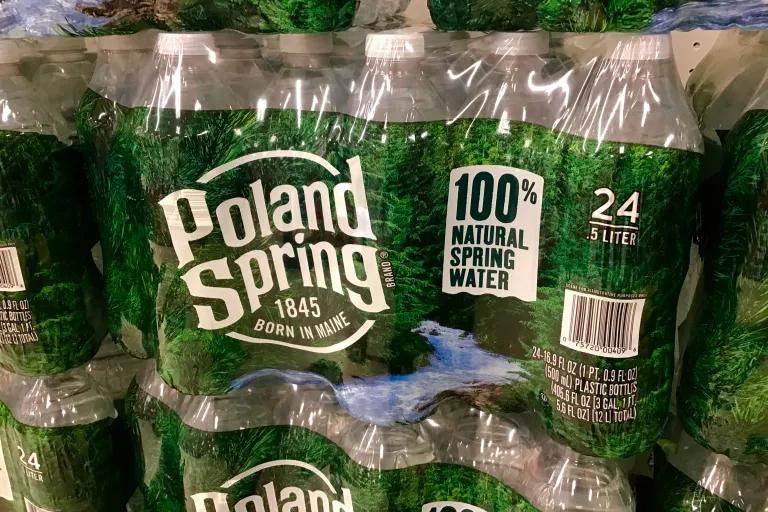
Poland Spring bottled water
Mike Mozart CC BY 4.0
Just scan the aisle of bottled water brands and you’ll notice a trend: packaging featuring scenic naturescapes and pristine rivers, lakes, and springs. In reality, the companies that manufacture bottled water are some of the world’s biggest contributors of plastic waste, and they often drain ecologically essential water resources in the process of sourcing. BlueTriton Brands—the company formerly known as Nestlé Waters—is behind a third of U.S. bottled-water brands, including Poland Spring.
More recently, BlueTriton faced litigation over its attempts to market its bottled water as sustainable, despite its “significant and ongoing contributions to plastic pollution and its depletion of natural water resources,” the lawsuit asserts. (Never mind that just making the plastic for a liter bottle of water takes three to four more liters of water.) In a motion to dismiss the case, BlueTriton’s attorneys defended the company by saying its “representation of itself as ‘a guardian of sustainable resources’ and ‘a company who, at its core, cares about water,’ is ‘vague and hyperbolic’” and therefore qualifies as “non-actionable puffery.” That’s about as close to a definition of greenwashing as you can get.
- Environmental buzzwords that have no legal weight—like “natural” or “eco-friendly”—and tell you little about a company’s specific sustainability practices are also everywhere. This language is intentionally vague enough to remain subjective and unregulated while still attempting to convince customers of a product’s benefits.

Clearcut area of Canada’s boreal forest, which has been continuously damaged by companies like P&G to produce toilet paper
River Jordan for NRDC
You should be especially skeptical of greenwashing tied to sectors known for their environmentally harmful practices—such as logging and the various industries it feeds. Exhibit A: tissue product manufacturers and toilet paper brands like Charmin. Procter & Gamble, the company that makes Charmin, created a catchy marketing slogan—“Protect, Grow, and Restore” forests. But the slogan only serves as smoke and mirrors for unsuspecting buyers who don’t know its supply chain includes pulp sourced from irreplaceable primary forests, which are key allies in our fight against climate change. Sometimes these buzzwords are even concealing downright poisonous business ventures, like the practice of “chemical recycling.” The phrase implies materials are turned into new plastic when it generally means plastic is burned to make fuel. That process can emit more greenhouse gases than fossil fuel–fired power plants.
Even labels that promote a specific benefit, like “BPA-free,” should be approached with caution. That’s because, as public health advocates note, the chemical industry leans on a laundry list of “regrettable substitutions,” i.e., similarly toxic chemicals that have become routine replacements for better-known offenders. “The problem is that we don’t start from the precautionary principle in the United States,” Larsen says, “which would say don’t use a chemical or something that can harm you until you’ve proven it’s safe. Our regulatory framework is that you can use anything you want until it’s proven that it can harm you—and that proof is very arduous.”
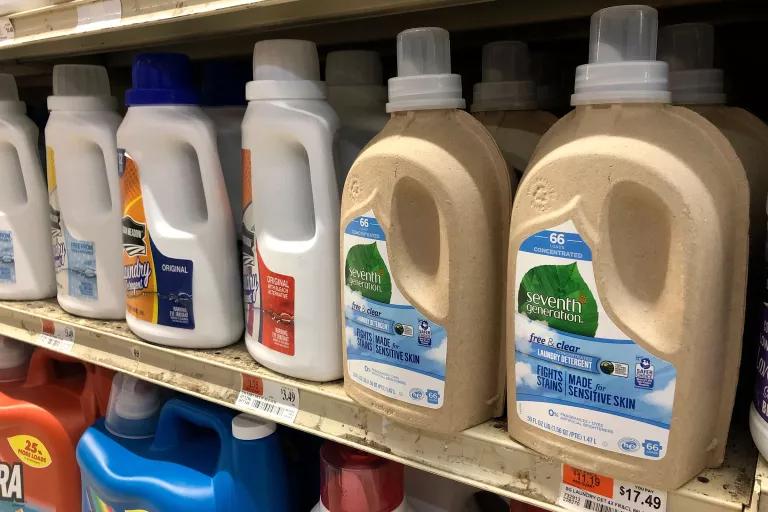
Seventh Generation’s cardboard laundry detergent container, which has a plastic pouch inside that many people are unlikely to separate for recycling
Lindsey Nicholson/UCG/Universal Images Group via Getty Images
- Products that lean on official-looking labels. Companies that produce plastic products often try to assuage consumer guilt by prominently featuring the ubiquitous recycling symbol or language like “please recycle” on the packaging. The logo may make someone feel like the choice is greener even if that type or mix of plastic is difficult to recycle in practice. It also puts no real onus on the manufacturer to actually reduce waste in its supply chain or to recycle, for that matter. As it stands, the world continues to recycle a meager 9 percent of the 440.9 million U.S. tons of plastic waste produced each year. Instead of these flimsy or false solutions, companies should take tangible steps, like reducing overall plastic use, upping the percentage of recycled content, or even investing in programs that help collect postconsumer waste.
- Companies that tout their latest (and even legitimate) sustainability initiative but that do so to draw attention away from the harmful activities making up the majority of their business practices.
When the company Ozinga Bros recently proposed building a massive “underground storage facility” below Chicago’s residential Southeast Side neighborhood, it laid the greenwashing on thick, says Gina Ramirez, NRDC’s Midwest outreach manager.
The company touted the possibility that its Invert mining project would eventually house green businesses, like solar panels or vertical gardens. However, Ramirez knew it’d more likely become a place for toxic industry to congregate in her already overburdened neighborhood. Ozinga Bros hoped to bolster its green reputation by planting trees, putting an environmental activist on its staff, and even building a community center that was quite literally decked out in green. But when it came to discussing the mine, they failed to provide studies on the expected impact to air quality or transportation. “You’ll see tree plantings, recycling, promises for green infrastructure,” Ramirez says, “but then the means to get that supposed green infrastructure is really hazardous to your health—like blowing up dynamite to mine for 17 years and bringing thousands of additional diesel trucks into the neighborhood.”
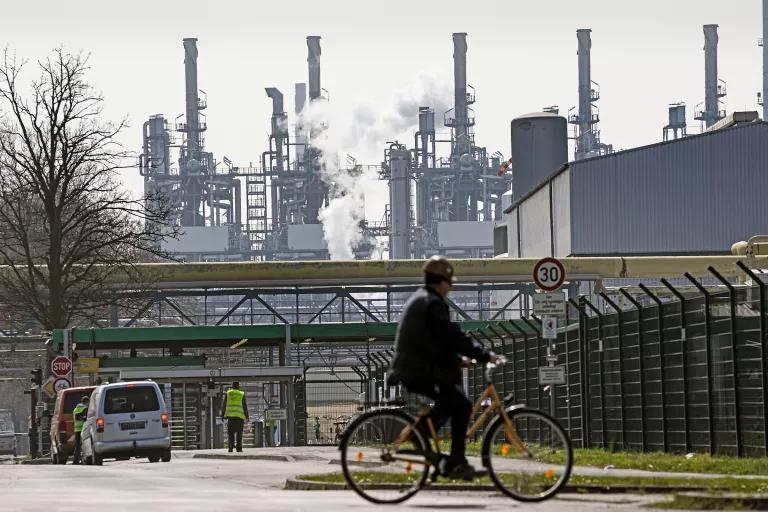
A worker riding their bicycle to the BP oil refinery in Gelsenkirchen, Germany
Martin Meissner/Associated Press
- Ambitious climate pledges that sound great on paper but offer few specific or quantifiable changes that actually reduce greenhouse gas emissions in the near term.
You’ve probably noticed that thousands of companies have publicly rolled out net-zero pledges, including fossil fuel companies like ExxonMobile and BP that have no intention of stopping further pollution-producing development. That’s because it’s possible to finagle the math to imply emissions reductions on paper while continuing business as usual or even increasing climate pollution.
The way that works is that companies can rely heavily on what are called “carbon offsets” to zero out their own emissions. These are commitments to take an action that reduces carbon emissions elsewhere, like paying to conserve carbon-rich land that otherwise would’ve been developed. But not only are the climate benefits of offsets not guaranteed—a “conserved” forest could be lost to an unexpected wildfire, for instance—there simply isn’t enough land available to allow everyone that plans to rely on offsets to do so. Without first changing polluting practices, these net-zero pledges are a form of greenwashing.
Why do companies greenwash?
Because going green sells. In 2021, 85 percent of global consumers said they considered the environment more when shopping than they did just five years prior, and at least a third said they are willing to spend more money for green products. This is particularly true for a new generation of socially conscious consumers. One recent study found that Gen Z considers climate change the single-greatest issue we face. “Purpose and impact are more in the minds of young people today,” says Andreas Rasche, greenwashing expert and professor at the Copenhagen Business School. Young people are both less willing to work for companies they perceive as misaligned with their values—and less willing to support them as consumers.
But, Racshe explains, it’s not just “the bad apples or the straightforward, rogue people trying to deceive others.” In his work, he often sees well-intentioned sustainability practices not living up to their promise because of mismanagement, poor internal communication, and a lack of sustainability expertise on staff.
How does greenwashing impact consumers?
Over time, greenwashing erodes consumer faith, which makes us more likely to dismiss environmental claims altogether—even the ones that are legitimate.
But there are far worse impacts too. Companies making these greenwashed products or running these greenwashed businesses and facilities have a history of setting up in low-income communities, communities of color, or both. For example, this trend held true for seven of the eight facilities NRDC researched during our investigation of chemical recycling. And the burning of that plastic, by the way, emits toxic chemicals linked to health problems like cancer and birth defects.
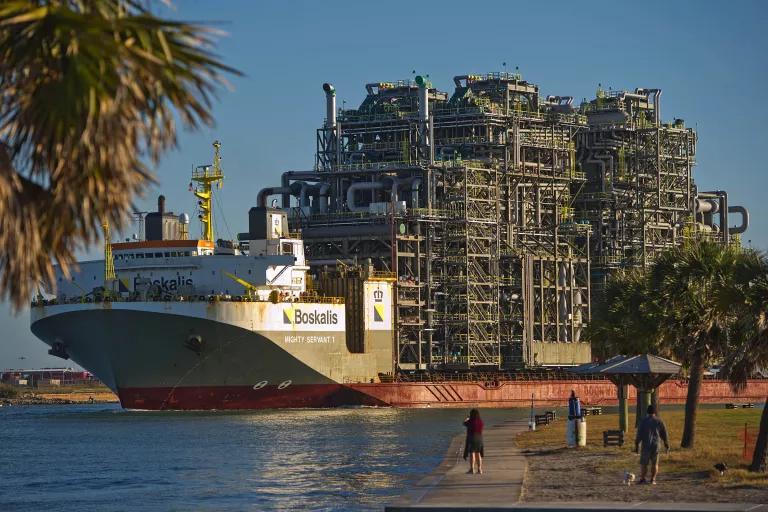
A furnace being delivered by barge to Gulf Coast Growth Ventures’ plastic manufacturing complex, a joint venture between ExxonMobil and SABIC, Corpus Christi, Texas
Eddie Seal/Bloomberg via Getty Images
What are the consequences for our environment?
Greenwashing gives some companies an unfair advantage. They are able to keep up with their polluting practices while simultaneously benefiting from the illusion of environmental stewardship. They can also make it harder for those who are doing the right thing to stand out in the marketplace. All of that has ongoing ripple effects for the environment. Take the Invert mine plans in Chicago. NRDC’s Ramirez pointed out that the drilling, explosions, and excavations would go on for years and kick up all kinds of pollutants. It’s worth noting that this includes pollution from prior polluters, as this neighborhood has long been treated like a dumping ground by toxic industries. The impact to the air alone is staggering but there will also be increased noise pollution and emissions. In other words, when it comes to greenwashing, public health and the environment stand to suffer.
What can be done to address greenwashing?
The best short-term means of tackling greenwashing is to build awareness. You’re doing that by just reading this piece. Plus, we’ve got an action-oriented guide to help you cut through most murky greenwashing waters. Consumer activism and consumer advocacy groups have also helped lead the way via third-party certifications, as have environmental advocacy groups demanding corporate accountability. But for long-term strategies, the government has to take steps to reduce the burden on consumers.
In the United States, the Federal Trade Commission is in charge of regulating unfair or deceptive marketing claims, including ones related to the environment, but the agency has gone after greenwashing violators fewer than 100 times since the early 1990s and seemingly only in the most egregious cases. There are other innovative ways forward that the United States could learn from. The European Union, for example, recently launched a taxonomy system that publicly ranks companies on their sustainability efforts according to a standardized set of criteria, creating more transparency for investors and policymakers. “It takes quite a bit of the ambiguity out of the debate,” says Rasche.
Ultimately, setting more protective environmental regulations at the outset can do a lot of the legwork. Federal agencies like the EPA and U.S. Food & Drug Administration must take the lead on restricting dangerous chemicals. And the U.S. Securities and Exchange Commission can hold greenwashing companies accountable for claims that mislead investors. Lawmakers at the state and local levels have a role to play too. In the case of Chicago’s Southeast Side, advocates are pushing for both a city ordinance and a state law to make it more difficult for companies to further target environmental justice communities like theirs. Activists exposing greenwashing schemes like this have shown us over and over again that what’s best for big business rarely matches what’s best for communities. And increasingly, their message is clear: Valuing profits over people will not be tolerated.
This NRDC.org story is available for online republication by news media outlets or nonprofits under these conditions: The writer(s) must be credited with a byline; you must note prominently that the story was originally published by NRDC.org and link to the original; the story cannot be edited (beyond simple things such as grammar); you can’t resell the story in any form or grant republishing rights to other outlets; you can’t republish our material wholesale or automatically—you need to select stories individually; you can’t republish the photos or graphics on our site without specific permission; you should drop us a note to let us know when you’ve used one of our stories.

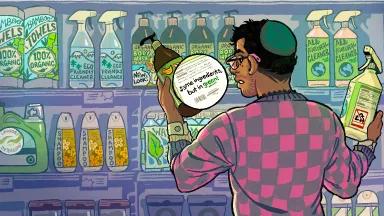
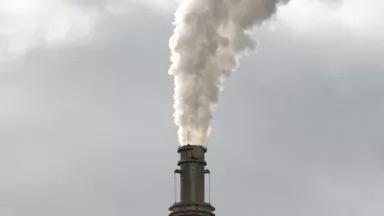

1.5 Degrees of Global Warming—Are We There Yet?
When Customers and Investors Demand Corporate Sustainability
What Are the Solutions to Climate Change?